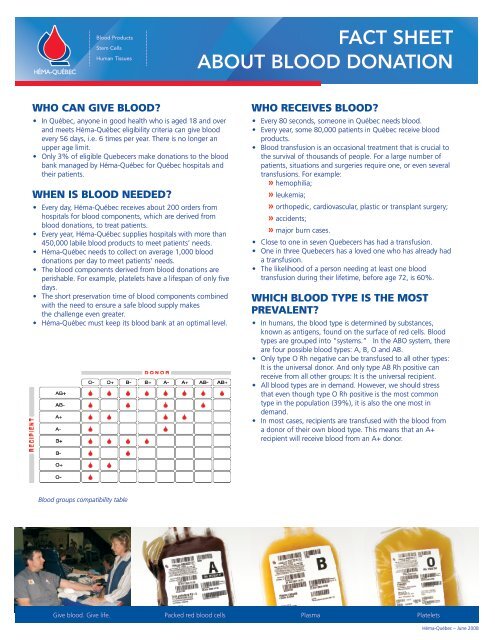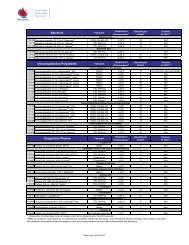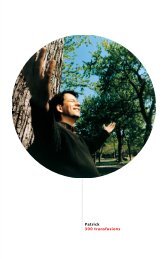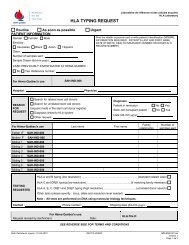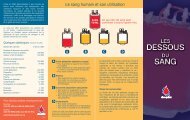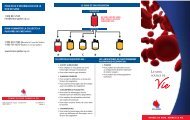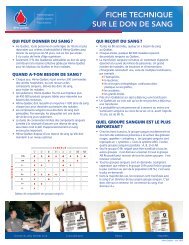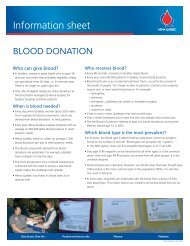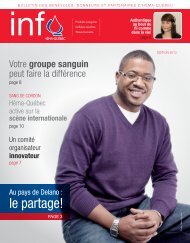FACT SHEET ABOUT BLOOD DONATION - Héma-Québec
FACT SHEET ABOUT BLOOD DONATION - Héma-Québec
FACT SHEET ABOUT BLOOD DONATION - Héma-Québec
Create successful ePaper yourself
Turn your PDF publications into a flip-book with our unique Google optimized e-Paper software.
Fact sheet<br />
about blood donation<br />
Who can give blood?<br />
• In Québec, anyone in good health who is aged 18 and over<br />
and meets Héma-Québec eligibility criteria can give blood<br />
every 56 days, i.e. 6 times per year. There is no longer an<br />
upper age limit.<br />
• Only 3% of eligible Quebecers make donations to the blood<br />
bank managed by Héma-Québec for Québec hospitals and<br />
their patients.<br />
When is blood needed?<br />
• Every day, Héma-Québec receives about 200 orders from<br />
hospitals for blood components, which are derived from<br />
blood donations, to treat patients.<br />
• Every year, Héma-Québec supplies hospitals with more than<br />
450,000 labile blood products to meet patients’ needs.<br />
• Héma-Québec needs to collect on average 1,000 blood<br />
donations per day to meet patients’ needs.<br />
• The blood components derived from blood donations are<br />
perishable. For example, platelets have a lifespan of only five<br />
days.<br />
• The short preservation time of blood components combined<br />
with the need to ensure a safe blood supply makes<br />
the challenge even greater.<br />
• Héma-Québec must keep its blood bank at an optimal level.<br />
Who receives blood?<br />
• Every 80 seconds, someone in Québec needs blood.<br />
• Every year, some 80,000 patients in Québec receive blood<br />
products.<br />
• Blood transfusion is an occasional treatment that is crucial to<br />
the survival of thousands of people. For a large number of<br />
patients, situations and surgeries require one, or even several<br />
transfusions. For example:<br />
» hemophilia;<br />
» leukemia;<br />
» orthopedic, cardiovascular, plastic or transplant surgery;<br />
» accidents;<br />
» major burn cases.<br />
• Close to one in seven Quebecers has had a transfusion.<br />
• One in three Quebecers has a loved one who has already had<br />
a transfusion.<br />
• The likelihood of a person needing at least one blood<br />
transfusion during their lifetime, before age 72, is 60%.<br />
Which blood type is the most<br />
prevalent?<br />
• In humans, the blood type is determined by substances,<br />
known as antigens, found on the surface of red cells. Blood<br />
types are grouped into “systems.” In the ABO system, there<br />
are four possible blood types: A, B, O and AB.<br />
• Only type O Rh negative can be transfused to all other types:<br />
It is the universal donor. And only type AB Rh positive can<br />
receive from all other groups: It is the universal recipient.<br />
• All blood types are in demand. However, we should stress<br />
that even though type O Rh positive is the most common<br />
type in the population (39%), it is also the one most in<br />
demand.<br />
• In most cases, recipients are transfused with the blood from<br />
a donor of their own blood type. This means that an A+<br />
recipient will receive blood from an A+ donor.<br />
Blood groups compatibility table<br />
1<br />
Give blood. Give life. Packed red blood cells Plasma Platelets<br />
<br />
<br />
Héma-Québec – June 2008
facts sheet<br />
on blood donation<br />
How is blood donated?<br />
• Anyone who meets all of the eligibility criteria for donors at a<br />
blood donation centre can give blood.<br />
• Although the overall blood donation process takes about 60<br />
minutes, the actual blood collection lasts about 10 minutes.<br />
• The entire blood collection process takes place under very<br />
strict conditions:<br />
» A Héma-Québec nurse settles the donor comfortably on<br />
a reclining chair and tells him/her to relax.<br />
» Several minutes later, the donor’s arm is carefully<br />
disinfected at the puncture site with two different<br />
antibacterial solutions to eliminate any risk of infection.<br />
» A new, sterile needle is inserted in the arm<br />
and connected to a sterile collection device.<br />
» During a donation, the collection device is rocked<br />
by an agitator to prevent the formation of clots; this<br />
device automatically stops the collection once the blood<br />
bag contains 450 millilitres.<br />
» When the bag is full and the needle is removed, a sterile<br />
gauze compress is applied to the donor’s arm.<br />
» The used needle is discarded and will be destroyed<br />
by incineration.<br />
» The donor applies pressure on the collection point<br />
for 5 minutes to stop the bleeding, and a small dressing<br />
is applied.<br />
» Next, a volunteer directs the donor to the recuperation<br />
area, and later gives him/her a snack.<br />
What happens to the blood<br />
after it is collected?<br />
• Before delivery to hospitals, the blood collected<br />
by Héma-Québec is processed to obtain the various blood<br />
components: Red cells, plasma, platelets and cryoprecipitate.<br />
This is why we say that one blood donation can save up to<br />
four lives.<br />
• Every blood donation is systematically analyzed<br />
and submitted to high precision screening tests for diseases<br />
that can be spread through blood transfusion, before being<br />
declared in compliance with the national safety standards<br />
issued by Health Canada.<br />
• The processing of whole blood into the various products<br />
results in a more effective treatment, since the patient will<br />
receive only the components he/she needs.<br />
• The processing starts with the receipt and recording of the<br />
blood bags in the blood management system. Thanks to this<br />
technology, the donations can be tracked at all times.<br />
• First, the whole blood is centrifuged to separate the red cells<br />
from the plasma. Next, the bag of plasma is centrifuged<br />
again to extract the platelets. The cryoprecipitate is obtained<br />
by freezing and thawing the plasma.<br />
• Almost all the white cells are eliminated by filtration, thereby<br />
reducing the risk of transfusion reaction.<br />
• After the processing, all of the products are placed in the<br />
quarantine area until all tests have been completed.<br />
Once the process is complete and the products that meet<br />
standards have been duly labelled, they are ready<br />
for shipment to Québec hospitals.<br />
• The components of a blood bag collected on Monday, for<br />
example, are ready for shipment by late Tuesday afternoon.<br />
Where can I donate blood?<br />
• At the three GLOBULE Blood Donor Centres (Place Versailles,<br />
Laurier Québec and the Héma-Québec building<br />
at 4045 Côte-Vertu Blvd. in Montréal);<br />
• At the Mobile Blood Donation Unit, which travels<br />
to industrial parks, campsites and shopping centres;<br />
• At one of the 2,000 days of mobile blood drives organized<br />
by community partners.<br />
For more information<br />
To find out more about the blood donation eligibility criteria,<br />
the blood drive sites and times, call 1-800-343-7264 or visit the<br />
Héma-Québec website at:<br />
www.hema-quebec.qc.ca<br />
2<br />
Give blood. Give life. GLOBULE Blood Donor Centres Mobile Blood Donation Unit<br />
<br />
<br />
Héma-Québec – June 2008


